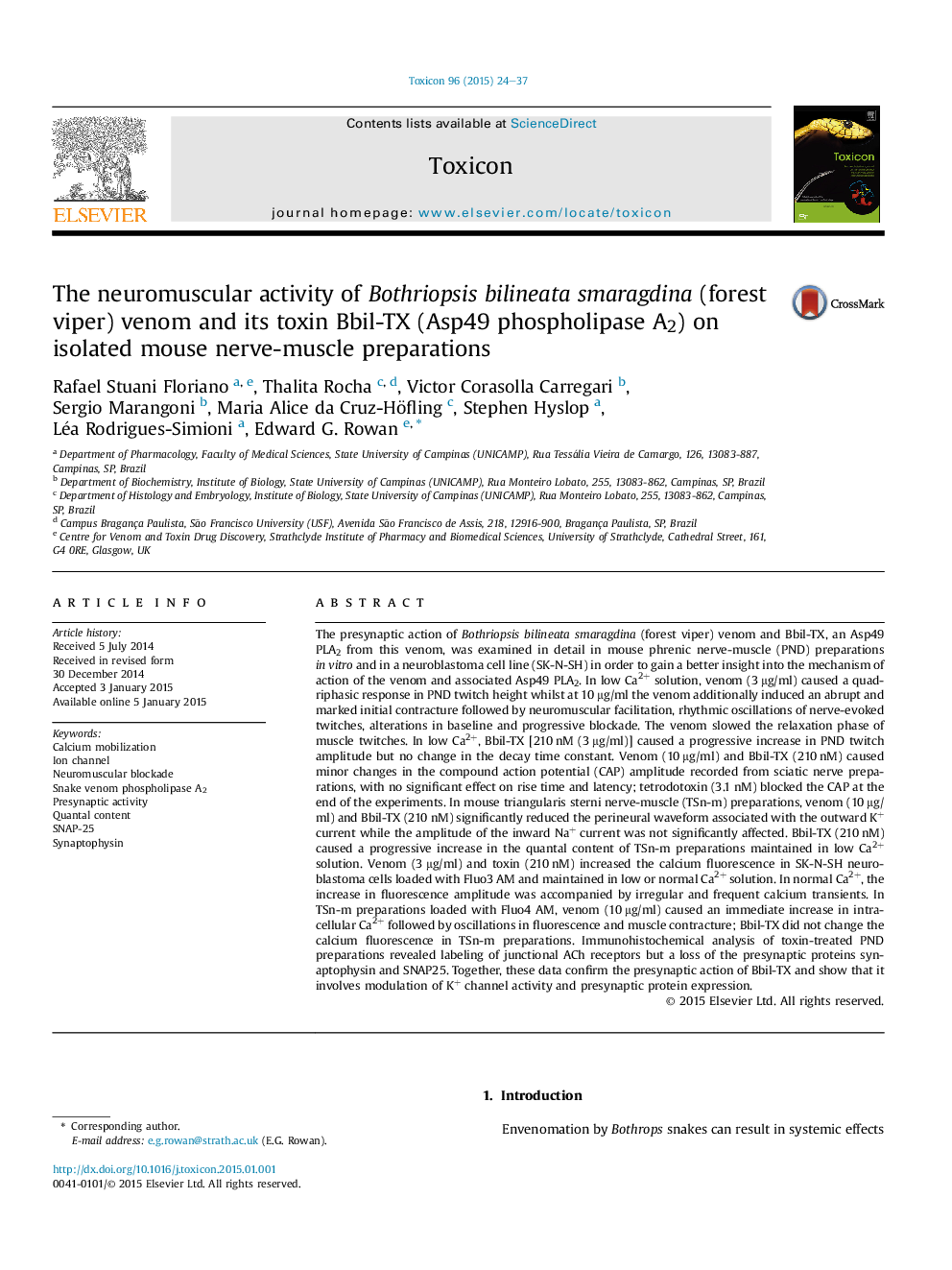| کد مقاله | کد نشریه | سال انتشار | مقاله انگلیسی | نسخه تمام متن |
|---|---|---|---|---|
| 2064495 | 1544139 | 2015 | 14 صفحه PDF | دانلود رایگان |

• The activity of Bothriopsis bilineata smaragdina (Bbs) venom was studied in detail.
• Quadriphasic changes in twitch amplitude were observed.
• Bbs-venom increased calcium fluorescence in SK-N-SH neuroblastoma cells.
• Bbs-venom caused a loss of synaptophysin and SNAP25 from nerve terminals.
• The complex pharmacology of Bbs-venom suggests the presence of a number toxins.
The presynaptic action of Bothriopsis bilineata smaragdina (forest viper) venom and Bbil-TX, an Asp49 PLA2 from this venom, was examined in detail in mouse phrenic nerve-muscle (PND) preparations in vitro and in a neuroblastoma cell line (SK-N-SH) in order to gain a better insight into the mechanism of action of the venom and associated Asp49 PLA2. In low Ca2+ solution, venom (3 μg/ml) caused a quadriphasic response in PND twitch height whilst at 10 μg/ml the venom additionally induced an abrupt and marked initial contracture followed by neuromuscular facilitation, rhythmic oscillations of nerve-evoked twitches, alterations in baseline and progressive blockade. The venom slowed the relaxation phase of muscle twitches. In low Ca2+, Bbil-TX [210 nM (3 μg/ml)] caused a progressive increase in PND twitch amplitude but no change in the decay time constant. Venom (10 μg/ml) and Bbil-TX (210 nM) caused minor changes in the compound action potential (CAP) amplitude recorded from sciatic nerve preparations, with no significant effect on rise time and latency; tetrodotoxin (3.1 nM) blocked the CAP at the end of the experiments. In mouse triangularis sterni nerve-muscle (TSn-m) preparations, venom (10 μg/ml) and Bbil-TX (210 nM) significantly reduced the perineural waveform associated with the outward K+ current while the amplitude of the inward Na+ current was not significantly affected. Bbil-TX (210 nM) caused a progressive increase in the quantal content of TSn-m preparations maintained in low Ca2+ solution. Venom (3 μg/ml) and toxin (210 nM) increased the calcium fluorescence in SK-N-SH neuroblastoma cells loaded with Fluo3 AM and maintained in low or normal Ca2+ solution. In normal Ca2+, the increase in fluorescence amplitude was accompanied by irregular and frequent calcium transients. In TSn-m preparations loaded with Fluo4 AM, venom (10 μg/ml) caused an immediate increase in intracellular Ca2+ followed by oscillations in fluorescence and muscle contracture; Bbil-TX did not change the calcium fluorescence in TSn-m preparations. Immunohistochemical analysis of toxin-treated PND preparations revealed labeling of junctional ACh receptors but a loss of the presynaptic proteins synaptophysin and SNAP25. Together, these data confirm the presynaptic action of Bbil-TX and show that it involves modulation of K+ channel activity and presynaptic protein expression.
Journal: Toxicon - Volume 96, 15 March 2015, Pages 24–37